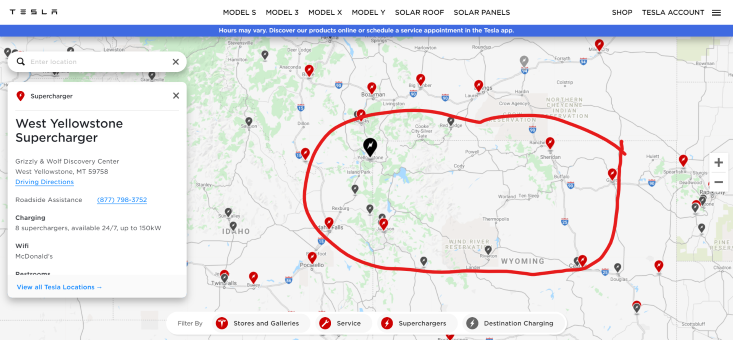After nearly 10 years of full-timing and >65,000 miles of motorhome driving over those years, my most memorable experiences have been away from the big cities. When I read some of the comments about superchargers being almost ubiquitous, it made me question are they really all that available?
Attached is a current supercharger map for the State of Wyoming. There are a total of 8 charging slots in West Yellowstone with another location in Jackson. Given the extent of Yellowstone and Grand Teton parks there are lots of places that are many miles from a charger over hilly terrain that will shorten range. Given the thousands of tourists who visit each year and the many, many miles you can drive in a single day of touring, that's not a lot of charging stations IMO.
By way of comparison, in 2019 we spent much of the summer on Prince Edward Island. I've attached a map of superchargers on PEI--there are none. The rural RV park we stayed at didn't even have 50A service. So much for recharging at night!
I'm not trying to rain on anyone's parade, but I don't see EVs as yet being practical in many rural areas. Yes, there appear to be plenty of charging stations in bigger cities, but if you live in a rural environment there aren't nearly as many.
In the winter we live outside of Corpus Christi TX, a city of >300k people. There are no superchargers in Corpus at the moment. Yes, we could recharge every night at home, but we would have to carefully plan day trips to ensure that we could be near a charger somewhere during the day since there are few between us and Houston or San Antonio.
As for hybrids, yes, they have "unlimited range" due to their gasoline engines, but most can only go a modest distance on electric power. When operating off their gasoline engines hybrids are basically no different from any other gasoline-powered cars with small engines. The benefit of regenerative braking, which is important in stop and go driving, is insignificant in open road driving.
In summary, I don't disagree that with an increase in charging stations EV's could replace many, if not all, IC-powered private vehicles and many more commercial ones. But IMHO I don't think we are there yet, at least not for meeting what I view as my personal requirements. As they say, the devil is always in the details.


